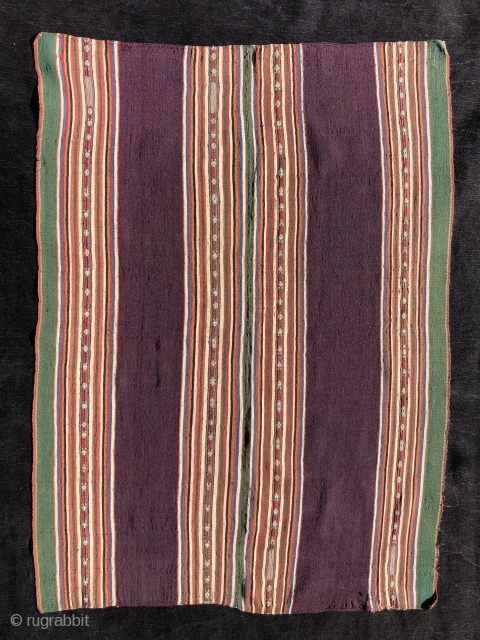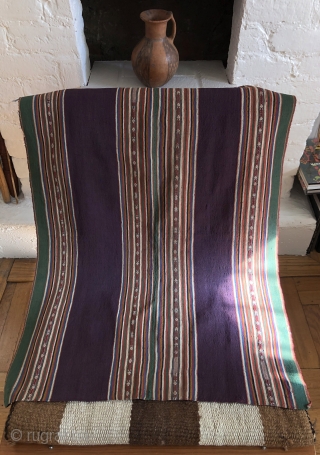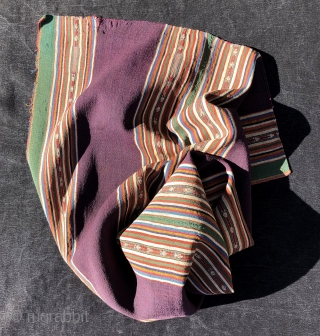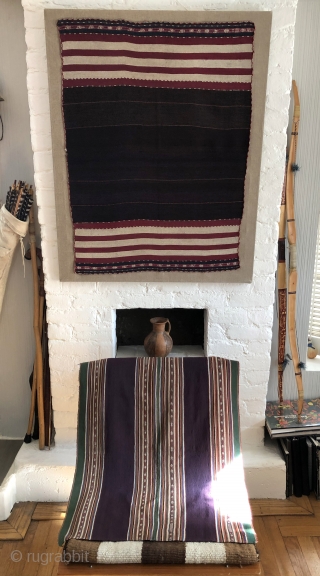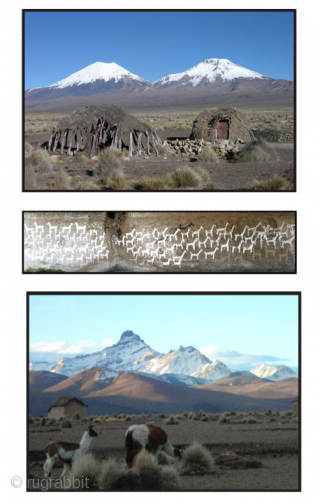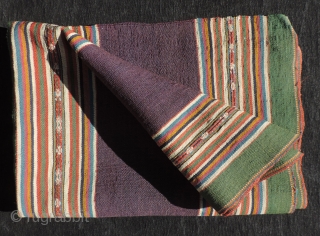Back
Fine Aymara woman's shoulder cloth. Lake Titicaca region 19th century. Textiles like this are the most finely woven of Aymara textiles. They often have red wefts concealed within the warp-faced weave which when worn produce a subtle shimmering effect as the red wefts become visible with movement. This is another example of the incredible sophistication of the Aymara weaving tradition. Remarkable cloth, drape and color are the primary features of these Andean textiles produced from the fiber of herds of alpacas raised at over 12,500 feet above sea level on the Bolivian Altiplano. This example in in near perfect condition and has a beautiful green color that is unusual and indicates good age. The deep purple tempered by red wefting is outstanding and derived from cochineal. The fineness of this textile is akin to that found in ancient pre-Columbian textiles from the Andes and is not seen in textiles outside the Aymara tradition in the rest of the Andes after the conquest in the 16th century. The Aymara maintained their weaving traditions after other weaving cultures in the Andes had long since lost theirs. a textile like this could be draped over a woman's shoulders or folded in a certain way and worn as a headdress for ceremonial occasions. The details in the fine stripes show pictograph-like figures that represent stars coca plants and a simple double-headed eagle-like form that derives from the crest of Spanish coats of arms adapted after the conquest in the region in 16th century. The larger blocks of speckled design seen in one image are actually an indication of the "termination" areas of the weaving. All Aymara textiles are four selvedged textiles. They are not cut from the loom upon completion which would leave a fringe. Instead, they are neatly finished by hand on the loom using needles and the primary design terminates in these finish areas producing the zipper-like pattern seen here. This is an admirable textile in excellent condition. Size: 25 x 35 inches.
price:
SOLD - THANK YOU
- Home
- Antique Rugs by Region
- Category
- Profiles
- Post Items Free
- Albums
- Benaki Museum of Islamic Art
- Budapest: Ottoman Carpets
- Gulbenkian Museum
- Islamic Carpets. Brooklyn
- Islamic Textiles. Brooklyn
- Konya Museum: Rugs
- MKG, Hamburg
- MMA: Caucasian Carpets
- MMA: Mamluk Carpets
- MMA: Mughal Indian Carpets
- MMA: Ottoman Carpets
- MMA: Safavid Persian Carpets
- MMA: Turkmen Rugs
- McCoy Jones Kilims
- Ottoman textiles. Met
- Philadelphia Museum
- Rugs and Carpets: Berlin
- Seljuqs at the Met
- TIEM, Istanbul: Carpets
- V&A: Classical Carpets
- Vakiflar Carpets: Istanbul
- Baluch Rugs: Indianapolis
- Gallery Exhibitions
- Jaf an Exhibition
- Alberto Levi Gallery
- Andean Textile
- Christie's London: 2016
- Francesca Galloway
- HALI at 40
- ICOC Washington, DC 2018
- Jajims of the Shahsavan
- London Islamic Week April, 2018
- Mongolian Felts
- Navajo Rugs: JB Moore
- Persian Piled Weavings
- SF Tribal & Textile Art Show 2020
- SF Tribal 2019
- Sotheby's: C. Alexander
- Turkish Prayer Rugs
- Turkmen Main Carpets ICOC 2007








